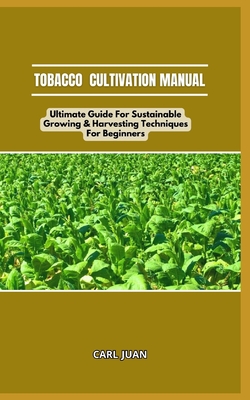Tobacco Cultivation Manual: Ultimate Guide For Sustainable Growing & Harvesting Techniques For Beginners

Tobacco Cultivation Manual: Ultimate Guide For Sustainable Growing & Harvesting Techniques For Beginners
There are normally multiple steps involved in the cultivation of tobacco:
1. In the first step, the soil is readied for the planting of tobacco seeds. For best results with seed germination and plant development, this seedbed is typically located in a greenhouse or other protected environment.
2. Seeds are sown in a nursery, and when the seedlings are big enough to transplant, they are moved to a field. This is a typical well-prepared field, with ideal soil conditions and fertilizer levels for growing tobacco.
3. Tobacco plants need continuing care, including watering, fertilizing, and insect control, after they have been transplanted. To improve the quantity and quality of the leaves, the plants should be clipped and topped.
4. Depending on the variety of tobacco being grown and the final product, the leaves are harvested at different stages of maturity. Depending on the needs, the entire plant or only a few selected leaves may be harvested.
5. Tobacco leaves are dried and cured after harvest to bring forth their natural flavors and aromas. Depending on the type of tobacco, the process may require air curing, flue curing, or fire curing.
6. Tobacco products start with cured leaves that are sorted, graded, and processed. Tobacco leaves can be processed in many ways, such as by shredding or cutting them for use in cigarettes and cigars, or left whole for use in whole-leaf chewing tobacco.
Many countries, including the United States, China, Brazil, and India, rely heavily on the agricultural profits from tobacco cultivation. Tobacco use is linked to a number of negative health outcomes, including an increased risk of cancer and cardiovascular disease, and therefore tobacco cultivation has a bad reputation. Consequently, several nations have tightened their regulations on tobacco production and the tobacco business as a whole
PRP: 68.12 Lei
Acesta este Prețul Recomandat de Producător. Prețul de vânzare al produsului este afișat mai jos.
61.31Lei
61.31Lei
68.12 LeiLivrare in 2-4 saptamani
Descrierea produsului
There are normally multiple steps involved in the cultivation of tobacco:
1. In the first step, the soil is readied for the planting of tobacco seeds. For best results with seed germination and plant development, this seedbed is typically located in a greenhouse or other protected environment.
2. Seeds are sown in a nursery, and when the seedlings are big enough to transplant, they are moved to a field. This is a typical well-prepared field, with ideal soil conditions and fertilizer levels for growing tobacco.
3. Tobacco plants need continuing care, including watering, fertilizing, and insect control, after they have been transplanted. To improve the quantity and quality of the leaves, the plants should be clipped and topped.
4. Depending on the variety of tobacco being grown and the final product, the leaves are harvested at different stages of maturity. Depending on the needs, the entire plant or only a few selected leaves may be harvested.
5. Tobacco leaves are dried and cured after harvest to bring forth their natural flavors and aromas. Depending on the type of tobacco, the process may require air curing, flue curing, or fire curing.
6. Tobacco products start with cured leaves that are sorted, graded, and processed. Tobacco leaves can be processed in many ways, such as by shredding or cutting them for use in cigarettes and cigars, or left whole for use in whole-leaf chewing tobacco.
Many countries, including the United States, China, Brazil, and India, rely heavily on the agricultural profits from tobacco cultivation. Tobacco use is linked to a number of negative health outcomes, including an increased risk of cancer and cardiovascular disease, and therefore tobacco cultivation has a bad reputation. Consequently, several nations have tightened their regulations on tobacco production and the tobacco business as a whole
Detaliile produsului










